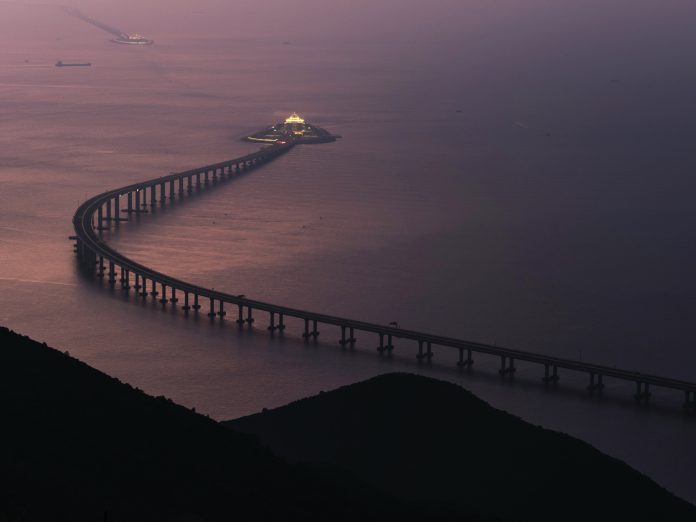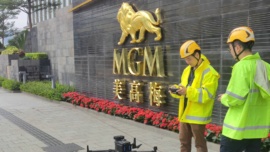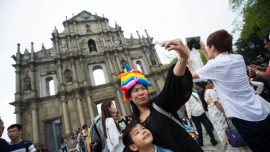China may be more concerned with the long-term, and political, issues of the bridge, but it must be acknowledged that the balance sheet for this first year is disappointing. The bridge has so little use that it is still brand new…
MB November Special Report | The ghost bridge
HZMB’s people in charge of the operation did not fail to take stock of this first year, but what they said is inextricably linked to the numbers of these first 12 months.
The Legislative Assembly’s Monitoring Committee on Public Administration Affairs set the tone in a report released in July: “How big is the difference from the objectives of the initial plan, the efficiency of this bridge must be raised overall.”
Over 15 pages, Macau MPs searched for “the reasons for the bridge’s low utilization rate”, using precisely the numbers of the two car parks on the artificial island. “However, the utilization rate of both parks did not meet the expected targets as there are many vacant places.”
We thus learned that by April, the East Auto Silo’s daily usage rate (for the parking of visitor vehicles) averaged 7 per cent, which means 235 seats were occupied from the 3,000 available. As for West Auto Silo (for Macau vehicles), the utilization rate ranged from 5 to 6 per cent (3089 seats available).
Nevertheless, other data from the Transport Bureau (DSAT), released in May, showed an even lower occupancy rate in both car parks (less than 3 per cent).
The bureau claimed that the low occupancy rate owes to the fact that over 80 per cent of visitors travelling on the super bridge favour the use of shuttle buses rather than driving.
The DSAT also noted that car parks on the Hong Kong checkpoint side had shortened their prior booking time from 12 hours to six hours, while Macau still keeps the statutory 12 hours for booking.

Other numbers:
Currently, 300 private car licenses and 300 corporate licenses are distributed on the Macau side. The Hong Kong side has 300 additional licenses for Macau SAR. Last October, DSAT announced that the number of allocated HZMB driving quotas increased to 914 three-year quotas for private cars registered in Macau, 558 for private applicants and 356 for commercial entities.
Marking the first anniversary, DSAT announced that those 914 vehicles will be authorized to cross the Shenzhen Bay border and Hong Kong vehicles will have the ‘green light’ to cross the Hengqin border crossing, on an experimental basis.
According to DSAT’s February data, there were about 130,000 tickets, the equivalent of 1,200 a day, representing only 10 per cent of the government’s forecast volume.
A feasibility study report completed in 2008 by the HZMB Advance Work Co-ordination Group and sent to the central government, estimated that the initial traffic on the bridge could reach between 9,200 to 14,000 vehicles per day.
However, fresh data shows that the bridge saw 1.15 million vehicles crossing it in 10 months at an average daily traffic of only 3,800.
Private cars were said to represent 47 per cent of the total traffic, followed by the Golden Bus daily shuttle bus service, which accounted for about 34 per cent of the total, while container truck traffic accounted for less than 10 per cent.
If cars are scarce on the bridge, then trucks are even more so. “There is still very little cargo going through [the bridge] because the rules are not clearly established with the customs authorities,” said Kerry Logistics CEO George Yeo.
In several months of this year, 3,500 freight vehicles have not reached the bridge, according to official figures from the Hong Kong-Zhuhai-Macau bridge managing authority.
In the first assessment made by the authority that manages the HZMB, after the opening of the work, it was stated that the traffic was “below expectations” and that there is [a] “large space” to increase the flow of vehicles, foreseeing greater access. “The traffic volume was low,” said Yu Lie, deputy director of the agency that manages the infrastructure. “After an initial period, an assessment will have to be made, and there is a possibility of increasing the number of quotas,” explained Yu Lie, pointing out that in the “long term” all cars in Macau and Hong Kong will use the bridge.
The Chairman of the Monitoring Committee, Si Ka Lon, has criticized the way traffic on the bridge is being managed. “The utilization rate is not high. Billions of patacas have been spent, and if it’s not taken full advantage [of], it’s not good.” Mr Zheng added: “We also hope we can have more quotas so that Macau vehicles can enter Hong Kong.” He also assured that “the Government of Macau has been in dialogue” with the authorities of the neighbouring region.
According to a recent Hong Kong Transport Department report, the governments of Guangdong and Hong Kong have agreed to relax the bridge access policy and give priority to the issue of quotas to some institutions, such as chambers of commerce, universities and research institutions.
“The utilization rate is not high. Billions of patacas have been spent, and if it’s not taken full advantage, it’s not good” – Zheng Anting
MOP30,000
The Macau Government first charged MOP30,000 to residents who wanted one of the 600 special license plates to use their private or commercial cars for Hong Kong, an amount that created a challenge, because Hong Kong did not charge anything for the equivalent license.
DSAT explained that the MOP30,000 was used to pay for Hong Kong’s registration formalities, noting that interested parties were exempt from when traveling to the surrounding region to address the issue.
In August, an order from the Chief Executive announced that the renewal of the 600 licenses would cost only MOP1,000.


























